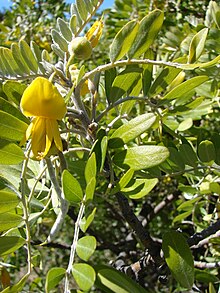Sophora
| Sophora | |
|---|---|
 |
|
| Sophora chrysophylla flowers and leaves | |
| Scientific classification | |
| Kingdom: | Plantae |
| (unranked): | Angiosperms |
| (unranked): | Eudicots |
| (unranked): | Rosids |
| Order: | Fabales |
| Family: | Fabaceae |
| Subfamily: | Faboideae |
| Tribe: | Sophoreae |
| Genus: |
Sophora L. |
| Type species | |
|
Sophora tomentosa L. |
|
| Species | |
|
59–116; see text. |
|
| Synonyms | |
59–116; see text.
Sophora is a genus of about 45 species of small trees and shrubs in the pea family Fabaceae. The species are native to southeast Europe, southern Asia, Australasia, various Pacific islands, western South America, the western United States, Florida and Puerto Rico. The generic name is derived from sophera, an Arabic name for a pea-flowered tree.
The genus formerly had a broader interpretation including many other species now treated in other genera, notably Styphnolobium (pagoda tree genus), which differs in lacking nitrogen fixing bacteria (rhizobia) on the roots, and Dermatophyllum (the mescalbeans). Styphnolobium has galactomannans as seed polysaccharide reserve, in contrast Sophora contains arabinogalactans, and Dermatophyllum amyloid.
The New Zealand Sophora species are known as Kowhai.
The Toromiro (Sophora toromiro) was formerly a common tree in the forests of Easter Island. The tree fell victim to the deforestation that eliminated the island's forests by the 18th century, and later became extinct in the wild. The tree is being reintroduced to the island in a scientific project partly led jointly by the Royal Botanic Gardens, Kew and the Göteborg Botanical Garden, where the only remaining plants of this species with a documented origin were propagated in the 1960s from seeds collected by Thor Heyerdahl.
...
Wikipedia
